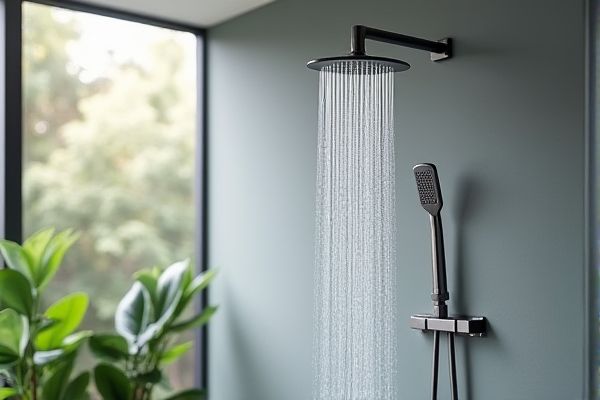
A rain shower offers a broad, gentle water flow that mimics natural rainfall, providing a soothing and immersive bathing experience, while a handheld shower delivers targeted water control and flexibility, ideal for rinsing specific areas or cleaning the shower itself. Discover which shower setup best suits Your needs by reading the rest of the article.
Table of Comparison
| Feature | Rain Shower | Handheld Shower |
|---|---|---|
| Water Coverage | Wide, gentle flow mimics natural rainfall | Targeted, adjustable spray for precise rinsing |
| Installation | Ceiling or wall-mounted; requires plumbing adjustments | Wall-mounted with flexible hose; easy retrofit |
| Flexibility | Fixed position, less maneuverable | Highly maneuverable; ideal for rinsing and cleaning |
| Water Pressure | Usually low to moderate; prioritizes gentle flow | Variable pressure, adjustable spray settings |
| Cleaning & Maintenance | Simple design, occasional descaling required | Frequent cleaning needed due to hose and nozzle |
| Cost | Typically higher initial cost and installation | Generally affordable and cost-effective |
| Best For | Luxury spa-like experience and relaxation | Practical use, mobility, and easy cleaning |
Introduction to Rain Showers and Handheld Showers
Rain showers provide a wide, gentle spray that mimics natural rainfall, offering a relaxing and immersive bathing experience ideal for large shower spaces. Handheld showers feature a detachable head connected by a flexible hose, allowing precise control and versatility for rinsing, cleaning, or bathing pets and children. Your choice between rain shower and handheld shower depends on whether you prioritize a spa-like ambiance or functional convenience.
Key Differences Between Rain Showers and Handheld Showers
Rain showers deliver a wide, gentle water flow from an overhead fixture designed to mimic natural rainfall, providing a luxurious and immersive bathing experience. Handheld showers feature a flexible hose and a detachable showerhead, allowing for targeted cleaning, greater mobility, and ease of use during tasks like rinsing and bathing children or pets. The primary distinction lies in rain showers offering fixed, broad coverage ideal for relaxation, whereas handheld showers provide versatility and precision for practical functionality.
Water Coverage and Spray Patterns
Rain showers provide wide water coverage through a large, flat showerhead that mimics natural rainfall with a gentle, consistent spray pattern ideal for full-body rinsing. Handheld showers offer adjustable spray patterns ranging from concentrated jets to softer mists, allowing targeted water flow and flexibility for washing specific areas. The combination of extensive coverage from rain showers and customizable sprays from handheld options caters to diverse bathing preferences.
Installation Requirements and Flexibility
Rain showers require more extensive installation with overhead plumbing, often needing reinforced ceiling support and precise water pressure calibration for optimal performance. Handheld showers offer flexible installation options, including wall mounts or slide bars, and are compatible with existing shower arms, making them easier to retrofit without major plumbing changes. The adaptability of handheld showers suits various bathroom layouts, while rain showers typically demand a dedicated, fixed setup for optimal water flow and ceiling height clearance.
Design and Aesthetic Appeal
Rain showers feature a sleek, modern design with wide, flat heads that create a luxurious waterfall effect, enhancing the aesthetic appeal of contemporary bathrooms. Handheld showers offer versatile designs that combine functionality with style, often featuring ergonomic handles and customizable spray patterns to complement various bathroom decors. Both options provide distinct visual and practical benefits, allowing homeowners to tailor their shower experience to personal tastes and bathroom design themes.
Ease of Cleaning and Maintenance
Rain showers typically feature a fixed overhead design with larger, evenly spaced nozzles, making them easier to clean as mineral buildup can be wiped off quickly without disassembling components. Handheld showers have smaller, more intricate nozzles and flexible hoses that may trap grime and require more frequent detailed cleaning to prevent clogging and maintain optimal water flow. Regular descaling and wiping of rain showers help maintain consistent water pressure, while handheld models demand careful attention to hose joints and spray heads for prolonged durability.
Water Efficiency and Eco-Friendliness
Rain showers typically consume more water due to their wide spray pattern, which can reduce water efficiency compared to handheld showers that allow targeted rinsing and better control of water flow. Handheld showers often feature eco-friendly settings such as low-flow nozzles and pause buttons, making it easier to minimize water usage during tasks like lathering or cleaning. Choosing a handheld shower with aerated or pressure-compensating technology enhances water conservation, supporting sustainable bathroom practices.
Shower Experience and Comfort
Rain showers provide a broad, gentle spray mimicking natural rainfall, offering a soothing and immersive bathing experience ideal for relaxation. Handheld showers deliver targeted water flow with adjustable angles and pressure, enhancing versatility and convenience for rinsing or cleaning specific areas. Combining both types can maximize comfort by balancing full-body coverage with precise control.
Cost Comparison and Value
Rain showers typically cost between $200 and $1,000, offering a luxurious shower experience with a wide spray pattern, while handheld showers range from $50 to $300, providing versatility and ease of use at a lower price point. The value of rain showers lies in their spa-like feel and aesthetic appeal, making them ideal for upscale bathroom renovations, whereas handheld showers offer practicality, especially for cleaning and accessibility, resulting in higher value for budget-conscious or functional-focused users. Choosing between the two depends on personal preference, bathroom layout, and weighing upfront cost against long-term enjoyment and utility.
Choosing the Right Shower for Your Bathroom
Rain showers offer a luxurious, spa-like experience with wide coverage and gentle water flow, ideal for creating a soothing atmosphere in modern bathrooms. Handheld showers provide versatility and targeted water delivery, making them perfect for cleaning specific areas or accommodating different user needs in compact or family bathrooms. Selecting the right shower depends on bathroom size, user preferences, and functionality requirements to enhance comfort and efficiency.
 homyna.com
homyna.com